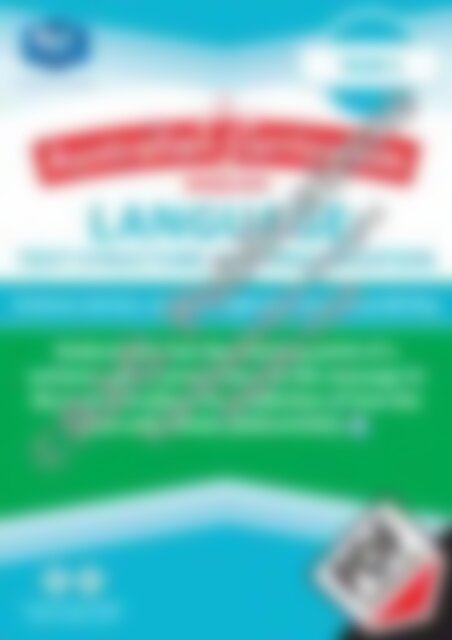20892 ACE Language (Yr 5) Sentence Starters beginnings and Text Prediction
You also want an ePaper? Increase the reach of your titles
YUMPU automatically turns print PDFs into web optimized ePapers that Google loves.
Your partner in education<br />
YEAR 5<br />
ENGLISH<br />
LANGUAGE:<br />
TEXT STRUCTURE AND ORGANISATION<br />
<strong>Sentence</strong> starters, sentence <strong>beginnings</strong> <strong>and</strong> text predicting<br />
Underst<strong>and</strong> that the starting point of a<br />
sentence gives prominence to the message in<br />
the text <strong>and</strong> allows for prediction of how the<br />
text will unfold (<strong>ACE</strong>LA1505)<br />
Australian Primary Publisher<br />
of the Year 2015 <strong>and</strong> 2016
Australian Curriculum English – <strong>Language</strong>: <strong>Text</strong> structure <strong>and</strong> organisation (Year 5)<br />
Foreword<br />
Australian Curriculum English – <strong>Language</strong>: <strong>Text</strong> structure <strong>and</strong> organisation (Year 5) is one in a series of seven teacher<br />
resource books that support teaching <strong>and</strong> learning activities in Australian Curriculum English. The books focus on<br />
the sub-str<strong>and</strong> of <strong>Text</strong> structure <strong>and</strong> organisation within the <strong>Language</strong> str<strong>and</strong> of the national English curriculum.<br />
The resource books include theoretical background information, activities to develop the content descriptions, blackline<br />
masters, resource sheets <strong>and</strong> assessment checklists, along with interrelated links to other English str<strong>and</strong>s <strong>and</strong> sub-str<strong>and</strong>s.<br />
Titles in this series are:<br />
• Australian Curriculum English – <strong>Language</strong>: <strong>Text</strong> structure <strong>and</strong> organisation (Foundation)<br />
• Australian Curriculum English – <strong>Language</strong>: <strong>Text</strong> structure <strong>and</strong> organisation (Year 1)<br />
• Australian Curriculum English – <strong>Language</strong>: <strong>Text</strong> structure <strong>and</strong> organisation (Year 2)<br />
• Australian Curriculum English – <strong>Language</strong>: <strong>Text</strong> structure <strong>and</strong> organisation (Year 3)<br />
• Australian Curriculum English – <strong>Language</strong>: <strong>Text</strong> structure <strong>and</strong> organisation (Year 4)<br />
• Australian Curriculum English – <strong>Language</strong>: <strong>Text</strong> structure <strong>and</strong> organisation (Year 5)<br />
• Australian Curriculum English – <strong>Language</strong>: <strong>Text</strong> structure <strong>and</strong> organisation (Year 6)<br />
Contents<br />
Format of this book .................................. iv – v<br />
<strong>Language</strong>: <strong>Text</strong> structure <strong>and</strong><br />
organisation .............................................. 2–81<br />
Underst<strong>and</strong> how texts vary in purpose, structure <strong>and</strong><br />
topic as well as the degree of formality (<strong>ACE</strong>LA1504)<br />
© Australian Curriculum: Assessment <strong>and</strong> Reporting Authority 2012<br />
–Teacher information ................................................. 2<br />
–Activities to develop the content description ...... 3–11<br />
–Blackline masters ............................................. 12–25<br />
–Assessment checklist ............................................. 26<br />
–Interrelated English links ........................................ 27<br />
– Modes, capabilities <strong>and</strong> priorities covered by the<br />
activities in this content description ........................27<br />
Underst<strong>and</strong> that the starting point of a sentence gives<br />
prominence to the message in the text <strong>and</strong> allows for<br />
prediction of how the text will unfold (<strong>ACE</strong>LA1505)<br />
© Australian Curriculum: Assessment <strong>and</strong> Reporting Authority 2012<br />
–Teacher information ............................................... 28<br />
–Activities to develop the content description .......... 29<br />
– Blackline masters <strong>and</strong><br />
resource sheets ................................................ 30–37<br />
–Assessment checklist ............................................. 38<br />
–Interrelated English links ........................................ 39<br />
– Modes, capabilities <strong>and</strong> priorities covered by the<br />
activities in this content description ....................... 39<br />
Underst<strong>and</strong> how the grammatical category of<br />
possessives is signalled through apostrophes <strong>and</strong> how<br />
to use apostrophes with common <strong>and</strong> proper nouns<br />
(<strong>ACE</strong>LA1506)<br />
© Australian Curriculum: Assessment <strong>and</strong> Reporting Authority 2012<br />
–Teacher information ............................................... 40<br />
–Activities to develop the content description .......... 41<br />
– Blackline masters<br />
<strong>and</strong> resource sheets ......................................... 42–56<br />
–Assessment checklist .............................................. 57<br />
–Interrelated English links ......................................... 58<br />
– Modes, capabilities <strong>and</strong> priorities covered by the<br />
activities in this content description......................... 58<br />
–Teachers notes ........................................................ 59<br />
Investigate how the organisation of texts into<br />
chapters, headings, subheadings (home pages <strong>and</strong><br />
sub pages for online texts) <strong>and</strong> according to<br />
chronology or topic, can be used to predict content<br />
<strong>and</strong> assist navigation (<strong>ACE</strong>LA1797)<br />
© Australian Curriculum: Assessment <strong>and</strong> Reporting Authority 2012<br />
–Teacher information ................................................ 60<br />
–Activities to develop the content description .......... 61<br />
– Blackline masters<br />
<strong>and</strong> resource sheets ......................................... 62–79<br />
–Assessment checklist .............................................. 80<br />
–Interrelated English links ......................................... 81<br />
– Modes, capabilities <strong>and</strong> priorities covered by the<br />
activities in this content description ........................ 81<br />
Answers .....................................................82–84<br />
R.I.C. Publications ® www.ricpublications.com.au Australian Curriculum English – <strong>Language</strong>: <strong>Text</strong> structure <strong>and</strong> organisation (Year 5)<br />
iii
Format of the book<br />
This teacher resource book includes supporting materials for teaching <strong>and</strong> learning in the sub-str<strong>and</strong> of <strong>Text</strong> structure<br />
<strong>and</strong> organisation within the str<strong>and</strong> of <strong>Language</strong> in Australian Curriculum English. All content descriptions in the substr<strong>and</strong><br />
have been included, as well as teaching points based on the Curriculum’s elaborations.<br />
While the book focuses on the sub-str<strong>and</strong> of <strong>Text</strong> structure <strong>and</strong> organisation, activities <strong>and</strong> interrelated links to other<br />
str<strong>and</strong>s <strong>and</strong> sub-str<strong>and</strong>s have been incorporated.<br />
Each section supports a specific content description <strong>and</strong> follows a consistent format, containing the following<br />
information over several pages:<br />
• activities to develop the content descriptions • student blackline masters • resource sheets<br />
• interrelated English links<br />
• assessment checklist<br />
Answers relating to student blackline masters have been included at the back of the book.<br />
The length of each content description section varies.<br />
Teacher information includes background information relating to the content description, as well as<br />
related terms <strong>and</strong> desirable student vocabulary <strong>and</strong> other useful details which may assist the teacher.<br />
Related terms includes vocabulary<br />
associated with the content description.<br />
Many of these relate to the glossary<br />
in the back of the official Australian<br />
Curriculum English document;<br />
additional related terms may also have<br />
been added.<br />
Student vocabulary includes words<br />
which the teacher would use—<br />
<strong>and</strong> expect the students to learn,<br />
underst<strong>and</strong> <strong>and</strong> use—during English<br />
lessons.<br />
Further resources by R.I.C.<br />
Publications ® or other publishers<br />
or authors are included where<br />
appropriate.<br />
<strong>Text</strong> structure<br />
<strong>and</strong> organisation<br />
Underst<strong>and</strong> how texts vary in purpose,<br />
Activities to<br />
structure <strong>and</strong> topic as well as the degree of<br />
formality (<strong>ACE</strong>LA1504)<br />
develop the<br />
© Australian Curriculum: Assessment <strong>and</strong> Reporting Authority 2012 content description<br />
E1. Analyses <strong>and</strong> identifies the most appropriate choice of text type for a given purpose <strong>and</strong> topic.<br />
? What this means<br />
provides a general<br />
explanation of the content<br />
description.<br />
Teaching points<br />
provides a list of<br />
the main teaching points<br />
relating to the content<br />
description.<br />
Elaborations are a<br />
list of elaborations<br />
based on those in the<br />
content description.<br />
Activities to develop the content<br />
description includes descriptions or<br />
instructions for activities or games<br />
relating to the content descriptions<br />
or elaborations. Some activities are<br />
supported by blackline masters or<br />
resource sheets. Where applicable,<br />
these will be stated for easy reference.<br />
Analysing text structures <strong>and</strong> language features of various text types (pages 12 to 25)<br />
Pages 5 to 11 provide teacher information, student activities <strong>and</strong> examples of seven imaginative, informative <strong>and</strong> persuasive text types written in<br />
the forms of a narrative, a procedure, a report, an explanation, an exposition, a discussion <strong>and</strong> a recount. These pages support the blackline masters<br />
provided on pages 12 to 25.<br />
Each text type in pages 5 to 11 includes:<br />
– information for the teacher about the various language <strong>and</strong> structural features, <strong>and</strong> the purpose of the specifi c text type<br />
– a detailed analysis of the structural <strong>and</strong> language features of the text presented in the sample texts provided on pages 12 to 25<br />
– suggested activities for helping students analyse structural <strong>and</strong> language features, <strong>and</strong> the purpose of the specifi c text type<br />
– answers for the student analysis worksheets, presented at the back of the book.<br />
Analysing texts<br />
In preparation for their own writing, provide students with a variety of appropriate text types across a range of topics. Analyse them by discussing the<br />
structure <strong>and</strong> language features, <strong>and</strong> the purpose, formality <strong>and</strong> intended audience. As the structures <strong>and</strong> language features are identifi ed, they can<br />
be presented in charts so that similarities <strong>and</strong> differences between different text types can be seen. The more students analyse the different text types<br />
written by others, the more able they will be in planning <strong>and</strong> writing their own.<br />
Using technology to present text types<br />
To help students identify the language features of text types, scan <strong>and</strong> enlarge the sample texts on pages 12 to 24 for use with an interactive<br />
whiteboard text program. Colour code the different language features <strong>and</strong> compare <strong>and</strong> contrast their use in different text types.<br />
Analysing the purpose of texts (page 4)<br />
Provide students with a variety of appropriate text types across a range of topics. Use the table on page 4 to help them analyse each text <strong>and</strong> answer<br />
the questions: Is it a factual or literary text type? Was it written to inform, to entertain or to persuade?<br />
<strong>Language</strong> <strong>and</strong> text structure revision/introduction activities<br />
As students need to identify language features such as verb tense, use of adverbs <strong>and</strong> adjectives to enhance <strong>and</strong> /or clarify meaning, identify pronouns<br />
<strong>and</strong> use of text connectives such as conjunctions, they will need revision/teaching to become familiar with these. The Primary grammar <strong>and</strong> word<br />
study series by R.I.C. Publications provides background information for the teacher, teaching suggestions <strong>and</strong> student worksheets on these aspects. The<br />
content description on pages 28 to 39 of this book also treats pronoun reference <strong>and</strong> text connectives in detail.<br />
Interrelated English links: See page 27.<br />
E2. Determines the degree of formality of text type appropriate for a given audience.<br />
Identifying the degree of formality in text types<br />
Provide students with a variety of appropriate text types across a range of topics. Suggest the possible intended audience giving reasons for suggestions.<br />
Informal text is written much as the spoken word. Formal text is written correctly but not as we would necessarily speak. Some examples of formal/<br />
informal features are:<br />
Features of formal text<br />
Features of informal text<br />
actions actions<br />
<br />
n<br />
<br />
casual style<br />
Altering the degree of formality in text types<br />
Having classifi ed texts as either formal or informal, convert them from one type to the other. To help with the degree of formality, suggest examples of<br />
people the students know or know of, to be the audience. This will help them to choose appropriate language <strong>and</strong> styles.<br />
R.I.C. Publications® www.ricpublications.com.au Australian Curriculum English – <strong>Language</strong>: <strong>Text</strong> structure <strong>and</strong> organisation (Year 5)<br />
3<br />
Australian Curriculum English – <strong>Language</strong>: <strong>Text</strong> structure <strong>and</strong> organisation (Year 5) www.ricpublications.com.au R.I.C. Publications ®<br />
iv
Format of the bookum.<br />
Blackline masters<br />
<strong>and</strong> resource sheets<br />
are provided to support<br />
teaching <strong>and</strong> learning<br />
activities for each content<br />
description. These include<br />
worksheets for class use,<br />
games, charts or other<br />
materials which the teacher<br />
might find useful to use or<br />
display in the classroom.<br />
For each blackline master or<br />
resource sheet, the content<br />
description to which it<br />
relates is given.<br />
Each section has a checklist<br />
which teachers may find useful as<br />
a place to keep a record of their<br />
observations of the activities to<br />
develop the content descriptions.<br />
Interrelated English links<br />
lists other links covered within<br />
the <strong>Language</strong> str<strong>and</strong>, Literature<br />
str<strong>and</strong> <strong>and</strong> Literacy str<strong>and</strong> of<br />
English that are incorporated in<br />
the activities provided with the<br />
content description. While the<br />
book’s approach focuses on the<br />
<strong>Text</strong> structure <strong>and</strong> organisation<br />
sub-str<strong>and</strong>, the links show the<br />
integration across the three<br />
str<strong>and</strong>s.<br />
A table showing the <strong>Language</strong><br />
modes, General capabilities<br />
<strong>and</strong> Cross-curriculum priorities<br />
covered by the activities in each<br />
content description is provided.<br />
Answers for student worksheets<br />
are provided at the back of the<br />
book.<br />
R.I.C. Publications ® www.ricpublications.com.au Australian Curriculum English – <strong>Language</strong>: <strong>Text</strong> structure <strong>and</strong> organisation (Year 5)<br />
v
<strong>Text</strong> structure<br />
<strong>and</strong> organisation<br />
Underst<strong>and</strong> that the starting point of a sentence gives prominence to the message in the<br />
text <strong>and</strong> allows for prediction of how the text will unfold (<strong>ACE</strong>LA1505)<br />
© Australian Curriculum: Assessment <strong>and</strong> Reporting Authority 2012<br />
Related terms<br />
<strong>Text</strong>s<br />
Written, spoken or multimodal forms of<br />
communication for a range of purposes. <strong>Text</strong><br />
forms, organisation <strong>and</strong> conventions have been<br />
developed to enhance effective communication.<br />
<strong>Sentence</strong><br />
A language unit consisting of one or more<br />
clauses which are linked grammatically. A<br />
written sentence starts with a capital letter<br />
<strong>and</strong> ends with a full stop, question mark or<br />
exclamation mark.<br />
<strong>Sentence</strong> starter<br />
The fi rst words of a sentence.<br />
<strong>Prediction</strong><br />
An informed presumption about something that<br />
might happen.<br />
Interrogatives<br />
Elements forming or constituting a question.<br />
Paragraph<br />
A group of related sentences that develop a<br />
central idea. A paragraph is indicated by a new<br />
line with a line space <strong>and</strong> may be indented or<br />
numbered.<br />
Topic sentence<br />
Usually the fi rst sentence in a paragraph which<br />
identifi es the main idea linking the sentences.<br />
Main idea<br />
The central theme which links information.<br />
?<br />
T<br />
E<br />
What this means<br />
Teacher information<br />
• <strong>Prediction</strong> is an essential reading <strong>and</strong> comprehending skill.<br />
• <strong>Sentence</strong> <strong>beginnings</strong> can be used to make predictions about the message in the text.<br />
• Students need to identify the starting point of a sentence <strong>and</strong> to realise its<br />
importance.<br />
• When composing sentences particular care should be given to deciding how to start<br />
them.<br />
Teaching points<br />
• When you read it is important to think about what is likely to be in the text.<br />
• There are many things in a text you can use to make predictions about what’s in it.<br />
• The beginning of a sentence can help a reader to predict what the sentence <strong>and</strong> the<br />
whole text could be about.<br />
• When you write sentences it’s important to think about how they start.<br />
Elaborations<br />
E1. Identifying sentence <strong>beginnings</strong> <strong>and</strong> observing how they are used to signal what<br />
sentences are about. Using this underst<strong>and</strong>ing to match sentence beginning <strong>and</strong><br />
endings.<br />
E2. Making predictions from sentence starters <strong>and</strong> using this information to complete<br />
sentences.<br />
Further resources<br />
• A time marker <strong>and</strong> tense activity for students: http://www.york.ac.uk/res/<br />
elanguages/index/Modulecd/cu2s6/cu2s60702.htm<br />
Student vocabulary<br />
sentence<br />
sentence starter<br />
main idea<br />
topic sentence<br />
paragraph<br />
prediction<br />
Australian Curriculum English – <strong>Language</strong>: <strong>Text</strong> structure <strong>and</strong> organisation (Year 5) www.ricpublications.com.au R.I.C. Publications ®<br />
28
<strong>Text</strong> structure<br />
<strong>and</strong> organisation<br />
Underst<strong>and</strong> that the starting point of a sentence gives<br />
prominence to the message in the text <strong>and</strong> allows for<br />
prediction of how the text will unfold (<strong>ACE</strong>LA1505)<br />
© Australian Curriculum: Assessment <strong>and</strong> Reporting Authority 2012<br />
Activities to<br />
develop the<br />
content description<br />
E1. Identifying sentence <strong>beginnings</strong> <strong>and</strong> observing how they are used to signal what sentences are<br />
about. Using this underst<strong>and</strong>ing to match sentence beginning <strong>and</strong> endings.<br />
• <strong>Sentence</strong> starter searches<br />
Discuss time markers as sentences starters with the class <strong>and</strong> compile a list on a large sheet of paper. Students can work with a partner to search in<br />
some different texts for more of them to add to the class list. This list should be displayed so it’s available for students to refer to when writing.<br />
This activity can then be extended to a different category of sentence starters, such as contrasting information or additional information <strong>and</strong> lists<br />
compiled for class reference.<br />
• Predicting from sentence <strong>beginnings</strong> (page 30)<br />
This resource sheet categorises some different types of sentence <strong>beginnings</strong>. Some examples of each type are included together with what each could<br />
indicate about the particular sentence it starts <strong>and</strong> the text generally.<br />
The resource page is intended as a starting point for class discussion <strong>and</strong> observation about what can be predicted from the fi rst words in a sentence.<br />
• Looking at sentence <strong>beginnings</strong> (page 31)<br />
This resource sheet sets out some short simple texts which are analysed to demonstrate how the sentence starter can predict the type of information<br />
which follows.<br />
These examples <strong>and</strong> the analyses may help to clarify the concept for teachers. It could be used for class demonstration <strong>and</strong> discussion.<br />
• Matching sentence starters (page 32)<br />
This activity requires students to carefully consider which of six sentence <strong>beginnings</strong> <strong>and</strong> ends match best. They should be encouraged to examine each<br />
option carefully, looking for <strong>and</strong> linking clues, such as ‘also’ <strong>and</strong> ‘In addition to this’, ‘both’ <strong>and</strong> ‘Similarly’, <strong>and</strong> ‘instead’ <strong>and</strong> ‘On the other h<strong>and</strong>’.<br />
• How does it end? (page 33)<br />
In this multiple choice activity students are given three options for completing sentences. Some are clearly incorrect but others require students to give<br />
careful thought to their selections. They should then be prepared to justify their choices to a small group or the class.<br />
Interrelated English links: See page 39.<br />
E2. Making predictions from sentence starters <strong>and</strong> using this information to complete sentences.<br />
• Using sentence starters (page 34)<br />
This activity provides the students with a choice of four sentence starters in the categories of: time markers, additional information, comparison <strong>and</strong><br />
contrast. They use their choice at the beginning of an appropriate sentence in each particular category.<br />
• What’s the next sentence? (page 35)<br />
Students read a sentence then use the sentence starter provided after it to write an associated sentence. They need to underst<strong>and</strong> the sentence opener<br />
must link the two sentences <strong>and</strong> the information in their new sentence must provide the type of information it signals. For example: ’At last’ is a time<br />
marker signalling a fi nal outcome, so this information needs to be part of the sentence they write.<br />
• What came before this? (page 36)<br />
Students are given a sentence. They are required to identify the sentence starter in it <strong>and</strong> then write a sentence which would be suitably placed before<br />
this particular sentence. It may be quite challenging for some students to work out the information they need to give in their sentence <strong>and</strong> to link it with<br />
the given sentence <strong>and</strong> its sentence starter.<br />
• Making a good start (page 37)<br />
The fi rst activity on this page provides an opportunity for students to improve text by replacing sentence starters in a paragraph. They can make their<br />
selections from a given list.<br />
The paragraph in the second activity needs different time markers to replace ‘then’. The new paragraph is to be written on a separate page.<br />
Interrelated English links: See page 39.<br />
R.I.C. Publications ® www.ricpublications.com.au Australian Curriculum English – <strong>Language</strong>: <strong>Text</strong> structure <strong>and</strong> organisation (Year 5)<br />
29
Predicting from sentence <strong>beginnings</strong><br />
Resource sheet<br />
The way a sentence begins can be used to make predictions about what’s in the sentence, what type of<br />
text it is <strong>and</strong> what it is likely to be about.<br />
Examples include:<br />
1. Once upon a time ...<br />
This sentence usually introduces the characters <strong>and</strong> setting of a fairytale.<br />
2. Dear Sir ... or Hi Jess ...<br />
These <strong>beginnings</strong> would indicate a letter <strong>and</strong> a less formal letter or email.<br />
3. C U L8R @ ...<br />
The beginning of this message indicates that it is a text message.<br />
4. Scene One: Boy enters ...<br />
This text indicates a playscript.<br />
5. www. ...<br />
This text indicates a link to a website.<br />
6. jimsmith@ ...<br />
This text is the beginning of an email address.<br />
7. Interrogatives (question words)<br />
These words indicate a question asking for information about something.<br />
• Where ... asks a question about a place<br />
• Who ... asks a question about a person or people<br />
• When ... asks a question about time<br />
• Why ... asks a question about a reason or reasons<br />
• What ... asks a question about information<br />
• How ... asks a question about manner, procedure or for an explanation<br />
8. Time markers<br />
These words indicate information about a point in time or the order of events.<br />
Later ..., Eventually ..., Shortly after ..., Before this ..., Gradually ..., Finally ..., Meanwhile ..., Before<br />
long ..., To begin with ..., Then ..., At last ..., At fi rst ...<br />
9. Additional information<br />
These words indicate further information or details will be provided.<br />
What’s more ..., Furthermore ..., In addition ..., Besides this ..., Also ...<br />
10. Comparative information<br />
Similarly ..., Also ..., At the same time ..., More specifi cally ..., After all ...<br />
11. Contrasting information<br />
Nevertheless ..., However ..., Conversely ..., On the other h<strong>and</strong> ...<br />
12. Cause <strong>and</strong> effect<br />
As a result ..., Therefore ..., This is why ..., As a consequence ... Accordingly ...<br />
13. Concluding <strong>and</strong> summarising<br />
In conclusion ..., Finally ..., In summary ..., Lastly ... To conclude ...<br />
Australian Curriculum English – <strong>Language</strong>: <strong>Text</strong> structure <strong>and</strong> organisation (Year 5) www.ricpublications.com.au R.I.C. Publications ®<br />
30<br />
Underst<strong>and</strong> that the starting point of a sentence gives prominence to the message in the text <strong>and</strong> allows for prediction of how the text will unfold (<strong>ACE</strong>LA1505)<br />
© Australian Curriculum: Assessment <strong>and</strong> Reporting Authority 2012
Looking at sentence <strong>beginnings</strong><br />
Resource sheet<br />
The sentence <strong>beginnings</strong>, even in a short, very simple text, can predict the type of information provided<br />
in those sentences.<br />
The following examples <strong>and</strong> analyses are simple explanations of how this could work.<br />
Sample informational text<br />
Whales are the largest mammals in the world.<br />
They have a blowhole to breathe air through.<br />
Underst<strong>and</strong> that the starting point of a sentence gives prominence to the message in the text <strong>and</strong> allows for prediction of how the text will unfold (<strong>ACE</strong>LA1505)<br />
© Australian Curriculum: Assessment <strong>and</strong> Reporting Authority 2012<br />
Many whales are toothless baleen whales that eat krill <strong>and</strong> plankton.<br />
However, some have teeth <strong>and</strong> eat fish <strong>and</strong> seals.<br />
Analysis of the sentence <strong>beginnings</strong> in the sample informational text<br />
Whales are – Indicates the sentence will be a fact <strong>and</strong> a definition.<br />
They have – The pronoun ’they’ indicates more information about whales.<br />
– The verb ’have’ indicates information about some characteristic.<br />
Many whales – Indicates specific information about particular species.<br />
However, some – Indicates some contrasting information.<br />
Sample blank informational text<br />
The following blank text has been provided to further demonstrate that the same sentence starters<br />
can be used to generate similar types of predictable information.<br />
Horses are<br />
They have<br />
Many horses<br />
However,<br />
Sample descriptive text<br />
My gr<strong>and</strong>father is a wise old man <strong>and</strong> everyone loves him.<br />
He has lots of wrinkles on his face <strong>and</strong> his arms are very brown.<br />
Many gr<strong>and</strong>fathers like to sit around <strong>and</strong> rest a lot.<br />
However, mine loves working hard all day in his garden <strong>and</strong> helping others.<br />
The similar sentences starters used in this text can generate similar types of predictable information<br />
<strong>and</strong> a similar analysis can be applied.<br />
R.I.C. Publications ® www.ricpublications.com.au Australian Curriculum English – <strong>Language</strong>: <strong>Text</strong> structure <strong>and</strong> organisation (Year 5)<br />
31
Matching sentence starters<br />
1. Read each sentence beginning, particularly the first words, think very carefully, then<br />
choose the best ending from the box <strong>and</strong> write it.<br />
• we thought there was no way he would wear such a dirty old tracksuit to school.<br />
• we both made a decision to protect the boy who was being bullied by walking home<br />
with him.<br />
• we could go to the football game instead <strong>and</strong> support our school team.<br />
• we were punished <strong>and</strong> we had to pick up rubbish at lunchtime.<br />
• we wanted to play with went off by themselves <strong>and</strong> said we couldn’t join them.<br />
• we also helped Dad with the gardening.<br />
(a) At lunchtime, the boys<br />
(b) Why did he do that,<br />
(c) As a consequence,<br />
(d) In addition to this,<br />
(e) Similarly,<br />
(f) On the other h<strong>and</strong>,<br />
Australian Curriculum English – <strong>Language</strong>: <strong>Text</strong> structure <strong>and</strong> organisation (Year 5) www.ricpublications.com.au R.I.C. Publications ®<br />
32<br />
Underst<strong>and</strong> that the starting point of a sentence gives prominence to the message in the text <strong>and</strong> allows for prediction of how the text will unfold (<strong>ACE</strong>LA1505)<br />
© Australian Curriculum: Assessment <strong>and</strong> Reporting Authority 2012
How does it end?<br />
Read the sentence beginning <strong>and</strong> tick the ending you think is the best match.<br />
1. As a result of this, ...<br />
(a) it was a wet <strong>and</strong> stormy day <strong>and</strong> I needed an umbrella.<br />
(b) my gr<strong>and</strong>father enjoys gardening <strong>and</strong> he grows lots of vegetables.<br />
(c) I’m a bit scared <strong>and</strong> I don’t walk to school by myself anymore.<br />
Underst<strong>and</strong> that the starting point of a sentence gives prominence to the message in the text <strong>and</strong> allows for prediction of how the text will unfold (<strong>ACE</strong>LA1505)<br />
© Australian Curriculum: Assessment <strong>and</strong> Reporting Authority 2012<br />
2. Some time later, ...<br />
(a) it will not surprise me when I can see better with my new glasses.<br />
(b) we kicked another goal <strong>and</strong> won the game.<br />
(c) my brother helps me with my homework project.<br />
3. To begin with, ...<br />
(a) there were only five of us who wanted to play.<br />
(b) we finished eating our meal before six o’clock.<br />
(c) we had to get out of the pool, get dressed <strong>and</strong> go home.<br />
4. Additionally, ...<br />
(a) we all worked hard to clean up our local park.<br />
(b) I would like you to know I have reported this matter to the police.<br />
(c) his skateboard is so old that it’s very difficult to ride.<br />
5. When ...<br />
(a) has that milk been put back in the refrigerator?<br />
(b) do you think will be elected school captain this year?<br />
(c) do you estimate this project will be completed?<br />
6. In conclusion, ...<br />
(a) I would like to thank all the people who have been so helpful.<br />
(b) the next event will be the most challenging.<br />
(c) I would like to welcome everyone to this meeting.<br />
7. On the other h<strong>and</strong>, ...<br />
(a) all of the students remembered to wear their sports uniforms.<br />
(b) if it’s raining we will have to cancel the event.<br />
(c) cyber bullying is a problem we also need to look at.<br />
R.I.C. Publications ® www.ricpublications.com.au Australian Curriculum English – <strong>Language</strong>: <strong>Text</strong> structure <strong>and</strong> organisation (Year 5)<br />
33
Using sentence starters<br />
1. Choose a time marker sentence starter <strong>and</strong> use it at the beginning of an interesting<br />
sentence.<br />
At first … Eventually … Meanwhile … At the beginning …<br />
2. Choose a sentence starter that will tell the reader that this sentence is providing<br />
additional information about something. Think about what information could have<br />
been in the sentence before yours, then write your sentence.<br />
In addition … Another way to … Furthermore … In fact …<br />
3. Write a sentence starting with one of the sentence starters telling the reader that<br />
something similar is being compared with what was in the previous sentence.<br />
In a similar way … Even if … In other words … At the same time …<br />
4. These sentence starters tell the reader that the information in it is different from what<br />
was in the sentence before it.<br />
On the other h<strong>and</strong> … Despite this … Nevertheless … However …<br />
Australian Curriculum English – <strong>Language</strong>: <strong>Text</strong> structure <strong>and</strong> organisation (Year 5) www.ricpublications.com.au R.I.C. Publications ®<br />
34<br />
Underst<strong>and</strong> that the starting point of a sentence gives prominence to the message in the text <strong>and</strong> allows for prediction of how the text will unfold (<strong>ACE</strong>LA1505)<br />
© Australian Curriculum: Assessment <strong>and</strong> Reporting Authority 2012
What’s the next sentence?<br />
1. Read the text <strong>and</strong> write the next sentence using the sentence starter.<br />
(a) The tired, dusty men had been trudging over the rough barren country for almost<br />
a week. At last, …<br />
Underst<strong>and</strong> that the starting point of a sentence gives prominence to the message in the text <strong>and</strong> allows for prediction of how the text will unfold (<strong>ACE</strong>LA1505)<br />
© Australian Curriculum: Assessment <strong>and</strong> Reporting Authority 2012<br />
(b) Aboriginal people cared for the l<strong>and</strong> on which they lived <strong>and</strong> they were concerned<br />
about conserving it for future generations. Similarly, …<br />
(c) It is considered to be particularly important that Australian students start to learn<br />
an Asian language while they are at school. Consequently, …<br />
(d) Our team trains hard every week, so we’ve been playing really well as a team <strong>and</strong><br />
we’ve won most of our games. On the other h<strong>and</strong>, …<br />
(e) If you want to play cricket at lunchtime you will need to leave this area <strong>and</strong> go<br />
down to the oval where hard cricket balls can’t hurt other students <strong>and</strong> where<br />
there aren’t any windows to break. In other words, …<br />
R.I.C. Publications ® www.ricpublications.com.au Australian Curriculum English – <strong>Language</strong>: <strong>Text</strong> structure <strong>and</strong> organisation (Year 5)<br />
35
What came before this?<br />
• Read each sentence <strong>and</strong> underline the<br />
sentence starter.<br />
• Think about what could have been<br />
in the sentence before it <strong>and</strong> write a<br />
suitable sentence in the space above it.<br />
1.<br />
2.<br />
3.<br />
4.<br />
However, I know that if I don’t go to the dentist <strong>and</strong> have my teeth checked every six<br />
months, I could end up with serious problems with them.<br />
Following that, the other boys in the class decided to wear their bike helmets all the<br />
time <strong>and</strong> to make sure they were done up correctly.<br />
In fact, it’s not only a disgrace, but I also think you should both be punished <strong>and</strong> I hope<br />
you have learnt a lesson <strong>and</strong> never do anything like that again.<br />
To conclude, I believe I have provided enough information to persuade you that<br />
building a playground so close to a busy road is not what our local government should<br />
be doing.<br />
Australian Curriculum English – <strong>Language</strong>: <strong>Text</strong> structure <strong>and</strong> organisation (Year 5) www.ricpublications.com.au R.I.C. Publications ®<br />
36<br />
Underst<strong>and</strong> that the starting point of a sentence gives prominence to the message in the text <strong>and</strong> allows for prediction of how the text will unfold (<strong>ACE</strong>LA1505)<br />
© Australian Curriculum: Assessment <strong>and</strong> Reporting Authority 2012
Underst<strong>and</strong> that the starting point of a sentence gives prominence to the message in the text <strong>and</strong> allows for prediction of how the text will unfold (<strong>ACE</strong>LA1505)<br />
© Australian Curriculum: Assessment <strong>and</strong> Reporting Authority 2012<br />
Making a good start<br />
It is important each sentence you write starts well. This is even more important when a<br />
sentence is the first one in a paragraph. These sentences are usually the topic sentence.<br />
They tell the main idea of the paragraph.<br />
1. (a) Read the paragraph, underline the topic sentence <strong>and</strong> circle the sentence starter in<br />
each of the sentences.<br />
(b) Read the sentence starters in the box below. Improve the paragraph by choosing a<br />
better one to write above some of those you circled.<br />
Bison calves These gigantic mammals Recently, In the past,<br />
A decision was made These young animals But by 1902 However,<br />
Bison are the largest l<strong>and</strong> mammals in North America. Bison are also known by their<br />
less formal name of buffalo. There were 30–60 million of these animals roaming the<br />
Great Plains in large herds. In 1902 the bison population had been dramatically<br />
reduced by hunters. In Yellowstone National Park there were only 23 bison left.<br />
They decided to place them under the protection of the US Army <strong>and</strong> there are now<br />
about 3000 to 4000 of them free to w<strong>and</strong>er through this huge park. Babies are born<br />
in April–May, which is spring. They are vulnerable to attacks<br />
from wolves <strong>and</strong> grizzly bears, their natural predators. A little<br />
while ago some wolves were reintroduced into Yellowstone,<br />
but this is not expected to affect bison numbers a great deal.<br />
But the situation will be carefully monitored.<br />
2. (a) Read the paragraph <strong>and</strong> underline each sentence starter.<br />
(b) Write the paragraph on a separate page using better sentence starters to replace<br />
some of those you underlined.<br />
After school on Wednesdays I go to swimming training. My mum has to pick me up<br />
from school as soon as it finishes. Then she drives me to the pool. I get changed as<br />
quickly as I can. Then I have to find my coach. Then he tells me which lane I have to swim<br />
in. Then I get in the pool <strong>and</strong> start my training program.<br />
Then my coach watches me <strong>and</strong> tells me what I could be<br />
doing better. Then I finish, have a shower <strong>and</strong> get changed<br />
again. I have to wait outside for Mum. Then we hurry home<br />
so I can have dinner. Then I have homework to do.<br />
R.I.C. Publications ® www.ricpublications.com.au Australian Curriculum English – <strong>Language</strong>: <strong>Text</strong> structure <strong>and</strong> organisation (Year 5)<br />
37
<strong>Text</strong> structure<br />
<strong>and</strong> organisation<br />
Underst<strong>and</strong> that the starting point of a sentence gives<br />
prominence to the message in the text <strong>and</strong> allows for<br />
prediction of how the text will unfold (<strong>ACE</strong>LA1505)<br />
© Australian Curriculum: Assessment <strong>and</strong> Reporting Authority 2012<br />
Assessment<br />
checklist<br />
Student Name<br />
Identifi es the starting<br />
point of a sentence<br />
<strong>and</strong> underst<strong>and</strong>s its<br />
importance<br />
Underst<strong>and</strong>s that<br />
a sentence starter<br />
is predictive of the<br />
sentence <strong>and</strong> the<br />
message in the text<br />
Matches sentence<br />
<strong>beginnings</strong> with<br />
most likely ending<br />
Uses sentence<br />
starters to<br />
predict text<br />
Australian Curriculum English – <strong>Language</strong>: <strong>Text</strong> structure <strong>and</strong> organisation (Year 5) www.ricpublications.com.au R.I.C. Publications ®<br />
38
<strong>Text</strong> structure<br />
<strong>and</strong> organisation<br />
Underst<strong>and</strong> that the starting point of a sentence gives<br />
prominence to the message in the text <strong>and</strong> allows for<br />
prediction of how the text will unfold (<strong>ACE</strong>LA1505)<br />
© Australian Curriculum: Assessment <strong>and</strong> Reporting Authority 2012<br />
Interrelated<br />
English<br />
links<br />
Below is a list of links within the <strong>Language</strong> str<strong>and</strong>, Literature str<strong>and</strong> <strong>and</strong> Literacy str<strong>and</strong> of English that are covered within the activities provided with the<br />
content description above:<br />
E1. Identifying sentence <strong>beginnings</strong> <strong>and</strong> observing how they are used to signal what sentences are about.<br />
Using this underst<strong>and</strong>ing to match sentence beginning <strong>and</strong> endings.<br />
• Navigate <strong>and</strong> read texts for specifi c purposes applying appropriate text processing strategies, for example predicting <strong>and</strong> confi rming, monitoring<br />
meaning, skimming <strong>and</strong> scanning (<strong>ACE</strong>LY1702)<br />
• Use comprehension strategies to analyse information, integrating <strong>and</strong> linking ideas from a variety of print <strong>and</strong> digital sources (<strong>ACE</strong>LY1703)<br />
• Develop a h<strong>and</strong>writing style that is becoming legible, fl uent <strong>and</strong> automatic (<strong>ACE</strong>LY1706)<br />
E2. Making predictions from sentence starters <strong>and</strong> using this information to complete sentences.<br />
• Underst<strong>and</strong> the use of vocabulary to express greater precision of meaning, <strong>and</strong> know that words can have different meaning in different contexts<br />
(<strong>ACE</strong>LA1512)<br />
• Underst<strong>and</strong> how to use banks of known words, as well as word origins, prefi xes <strong>and</strong> suffi xes, to learn <strong>and</strong> spell new words (<strong>ACE</strong>LA1513)<br />
• Navigate <strong>and</strong> read texts for specifi c purposes applying appropriate text processing strategies, for example predicting <strong>and</strong> confi rming, monitoring<br />
meaning, skimming <strong>and</strong> scanning (<strong>ACE</strong>LY1702)<br />
• Use comprehension strategies to analyse information, integrating <strong>and</strong> linking ideas from a variety of print <strong>and</strong> digital sources (<strong>ACE</strong>LY1703)<br />
• Reread <strong>and</strong> edit student’s own <strong>and</strong> others’ work using agreed criteria for text structure <strong>and</strong> language features (<strong>ACE</strong>LY1705)<br />
• Develop a h<strong>and</strong>writing style that is becoming legible, fl uent <strong>and</strong> automatic (<strong>ACE</strong>LY1706)<br />
The above links are reproduced with permission from ACARA.<br />
© Australian Curriculum: Assessment <strong>and</strong> Reporting Authority 2012<br />
Modes, capabilities <strong>and</strong> priorities covered by the<br />
activities in this content description<br />
<strong>Language</strong> modes General capabilities<br />
Listening Literacy ✔<br />
Speaking<br />
Reading ✔<br />
Viewing<br />
Numeracy<br />
Information <strong>and</strong> communication<br />
technology (ICT) capability<br />
Critical <strong>and</strong> creative thinking<br />
Writing ✔ Personal <strong>and</strong> social capability<br />
Ethical behaviour<br />
Intercultural underst<strong>and</strong>ing<br />
Cross-curriculum priorities<br />
Aboriginal <strong>and</strong> Torres Strait Isl<strong>and</strong>er histories <strong>and</strong> cultures<br />
Asia <strong>and</strong> Australia’s engagement in Asia<br />
Sustainability<br />
R.I.C. Publications ® www.ricpublications.com.au Australian Curriculum English – <strong>Language</strong>: <strong>Text</strong> structure <strong>and</strong> organisation (Year 5)<br />
39
<strong>Text</strong> structure<br />
<strong>and</strong> organisation<br />
Underst<strong>and</strong> that the starting point of a sentence gives<br />
prominence to the message in the text <strong>and</strong> allows for<br />
prediction of how the text will unfold (<strong>ACE</strong>LA1505)<br />
© Australian Curriculum: Assessment <strong>and</strong> Reporting Authority 2012<br />
Answers<br />
Matching sentence starters .............................page 32<br />
1. (a) At lunchtime, the boys we wanted to play with went off by<br />
themselves <strong>and</strong> said we couldn’t join them.<br />
(b) Why did he do that, we thought there was no way he would wear<br />
such a dirty old tracksuit to school.<br />
(c) As a consequence, we were punished <strong>and</strong> we had to pick up<br />
rubbish at lunchtime.<br />
(d) In addition to this, we also helped Dad with the gardening.<br />
(e) Similarly, we both made a decision to protect the boy who was<br />
being bullied by walking home with him.<br />
(f) On the other h<strong>and</strong>, we could go to the football game instead <strong>and</strong><br />
support our school team.<br />
How does it end? .............................................page 33<br />
1. (c) 2. (b) 3. (a) 4. (b)<br />
5. (c) 6. (a) 7. (b)<br />
Using sentence starters ...................................page 34<br />
1.–4. Teacher check<br />
What’s the next sentence? ..............................page 35<br />
1. (a)–(e) Teacher check<br />
What came before this? ..................................page 36<br />
1. <strong>Sentence</strong> starter: However, <strong>Sentence</strong>: Teacher check<br />
2. <strong>Sentence</strong> starter: Following that, <strong>Sentence</strong>: Teacher check<br />
3. <strong>Sentence</strong> starter: In fact, <strong>Sentence</strong>: Teacher check<br />
4. <strong>Sentence</strong> starter: To conclude, <strong>Sentence</strong>: Teacher check<br />
Making a good start ........................................page 37<br />
1. (a) Bison are the largest l<strong>and</strong> mammals in North America.<br />
Bison, There were, In 1902, In Yellowstone National Park,<br />
They decided, Babies, They are, A little while ago, But<br />
(b) Bison are the largest l<strong>and</strong> mammals in North America. These<br />
gigantic mammals are also known by their less formal name of<br />
buffalo. In the past, 30–60 million of these animals roamed the<br />
Great Plains in large herds. But by 1902, the bison population had<br />
been dramatically reduced by hunters. In Yellowstone National Park<br />
there were only 23 bison left. A decision was made to place them<br />
under the protection of the US Army <strong>and</strong> there are now about 3000<br />
to 4000 of them free to w<strong>and</strong>er through this huge park. Bison<br />
calves are born in April–May, which is spring. These young animals<br />
are vulnerable to attacks from wolves <strong>and</strong> grizzly bears, their<br />
natural predators. Recently, some wolves were reintroduced into<br />
Yellowstone, but this is not expected to affect their numbers a great<br />
deal. However, the situation will be carefully monitored.<br />
2. (a) After school, My mum, Then she, I get, Then I, Then he, Then I, Then<br />
my coach, Then I, I have to, Then we, Then I<br />
(b) Teacher check<br />
Time marker sentence starters may include:<br />
First, Finally, Once, At last, Meanwhile, When, Eventually, Later,<br />
Soon, As soon as, Sometimes, An hour later, Immediately, Next,<br />
During<br />
R.I.C. Publications ® www.ricpublications.com.au Australian Curriculum English – <strong>Language</strong>: <strong>Text</strong> structure <strong>and</strong> organisation (Year 5)<br />
83


















